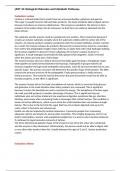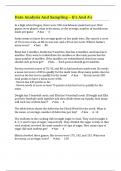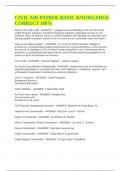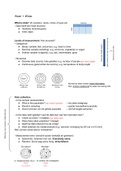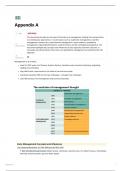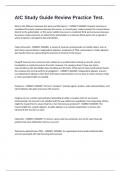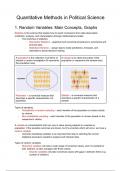Physics Cambridge A & AS Level Notes
CATALOG
Unit 1: Kinematics
— Pg 2 ~ 3
Unit 2: Accelerated Motion
— Pg 4 ~ 5
Unit 3: Dynamics
— Pg 6 ~ 8
Unit 4: Forces
— Pg 9 ~ 10
Unit 5: Work, Energy and Power
— Pg 11 ~ 13
Unit 6: Momentum
— Pg 14 ~ 16
Unit 7: Matters and Materials
— Pg 17 ~ 19
Unit 8: Electric Current
— Pg 20 ~ 22
(Side note: if you are able to open it in Google Docs, you will be able to get to the unit notes
directly by pressing the unit directly in the catalog)
1
,Kinematics
Kinematics is the study of motion, specifically the motion of objects without considering the
forces causing the motion. In A Level Physics, kinematics covers the concepts of displacement,
velocity, and acceleration, as well as their relationships with time. It also includes the analysis of
motion under different conditions such as uniform motion, non-uniform motion, and motion in a
straight line or in two dimensions.
Some key equations used in kinematics include:
● Displacement (s) = final position (x) - initial position (x0)
● Average velocity (v) = displacement (s) / time interval (t)
● Instantaneous velocity (v) = limit as time interval approaches zero of displacement (s) /
time interval (t)
● Average acceleration (a) = change in velocity (v) / time interval (t)
● Instantaneous acceleration (a) = limit as time interval approaches zero of change in
velocity (v) / time interval (t)
These equations can be used to solve various types of kinematics problems, such as calculating
the velocity or acceleration of an object given its displacement or time, or determining the
displacement or time given the velocity or acceleration.
Some Key Points for the facts section of the Unit of Kinematics
1. Kinematics is the study of motion without considering the forces that cause the motion.
2. Motion is described using different quantities, such as distance, displacement, speed,
velocity, and acceleration.
3. Distance is the total path covered by an object, while displacement is the distance
between the initial and final position of the object.
4. Speed is the rate of change of distance, while velocity is the rate of change of
displacement. Velocity includes both the speed and the direction of motion.
5. Acceleration is the rate of change of velocity. It can be positive or negative, depending
on whether the object is speeding up or slowing down.
6. The equations of motion are a set of equations that describe the relationships between
displacement, velocity, acceleration, and time for objects moving with constant
acceleration.
7. The four equations of motion are:
● s = ut + 1/2 at^2
● v = u + at
● s = (u + v)t/2
● v^2 = u^2 + 2as
2
, 8. where s is the displacement, u is the initial velocity, v is the final velocity, a is the
acceleration, and t is the time.
9. Projectile motion is the motion of an object that is thrown or launched into the air. It
follows a parabolic path due to the combination of its horizontal and vertical components
of velocity.
10. The range of a projectile is the horizontal distance it travels before landing back on the
ground. The maximum height of the projectile can be calculated using the equation h =
u^2 sin^2 θ/2g, where h is the maximum height, u is the initial velocity, θ is the angle of
projection, and g is the acceleration due to gravity.
11. The concept of relative motion is important when dealing with moving objects. The
velocity of an object can be measured relative to another object or a frame of reference.
Key Points of graph of the unit of Kinematics
1. Displacement-time graph shows the change in displacement over time
2. Velocity-time graph shows the change in velocity over time
3. Acceleration-time graph shows the change in acceleration over time
4. The gradient of a displacement-time graph gives the velocity
5. The gradient of a velocity-time graph gives the acceleration
3
CATALOG
Unit 1: Kinematics
— Pg 2 ~ 3
Unit 2: Accelerated Motion
— Pg 4 ~ 5
Unit 3: Dynamics
— Pg 6 ~ 8
Unit 4: Forces
— Pg 9 ~ 10
Unit 5: Work, Energy and Power
— Pg 11 ~ 13
Unit 6: Momentum
— Pg 14 ~ 16
Unit 7: Matters and Materials
— Pg 17 ~ 19
Unit 8: Electric Current
— Pg 20 ~ 22
(Side note: if you are able to open it in Google Docs, you will be able to get to the unit notes
directly by pressing the unit directly in the catalog)
1
,Kinematics
Kinematics is the study of motion, specifically the motion of objects without considering the
forces causing the motion. In A Level Physics, kinematics covers the concepts of displacement,
velocity, and acceleration, as well as their relationships with time. It also includes the analysis of
motion under different conditions such as uniform motion, non-uniform motion, and motion in a
straight line or in two dimensions.
Some key equations used in kinematics include:
● Displacement (s) = final position (x) - initial position (x0)
● Average velocity (v) = displacement (s) / time interval (t)
● Instantaneous velocity (v) = limit as time interval approaches zero of displacement (s) /
time interval (t)
● Average acceleration (a) = change in velocity (v) / time interval (t)
● Instantaneous acceleration (a) = limit as time interval approaches zero of change in
velocity (v) / time interval (t)
These equations can be used to solve various types of kinematics problems, such as calculating
the velocity or acceleration of an object given its displacement or time, or determining the
displacement or time given the velocity or acceleration.
Some Key Points for the facts section of the Unit of Kinematics
1. Kinematics is the study of motion without considering the forces that cause the motion.
2. Motion is described using different quantities, such as distance, displacement, speed,
velocity, and acceleration.
3. Distance is the total path covered by an object, while displacement is the distance
between the initial and final position of the object.
4. Speed is the rate of change of distance, while velocity is the rate of change of
displacement. Velocity includes both the speed and the direction of motion.
5. Acceleration is the rate of change of velocity. It can be positive or negative, depending
on whether the object is speeding up or slowing down.
6. The equations of motion are a set of equations that describe the relationships between
displacement, velocity, acceleration, and time for objects moving with constant
acceleration.
7. The four equations of motion are:
● s = ut + 1/2 at^2
● v = u + at
● s = (u + v)t/2
● v^2 = u^2 + 2as
2
, 8. where s is the displacement, u is the initial velocity, v is the final velocity, a is the
acceleration, and t is the time.
9. Projectile motion is the motion of an object that is thrown or launched into the air. It
follows a parabolic path due to the combination of its horizontal and vertical components
of velocity.
10. The range of a projectile is the horizontal distance it travels before landing back on the
ground. The maximum height of the projectile can be calculated using the equation h =
u^2 sin^2 θ/2g, where h is the maximum height, u is the initial velocity, θ is the angle of
projection, and g is the acceleration due to gravity.
11. The concept of relative motion is important when dealing with moving objects. The
velocity of an object can be measured relative to another object or a frame of reference.
Key Points of graph of the unit of Kinematics
1. Displacement-time graph shows the change in displacement over time
2. Velocity-time graph shows the change in velocity over time
3. Acceleration-time graph shows the change in acceleration over time
4. The gradient of a displacement-time graph gives the velocity
5. The gradient of a velocity-time graph gives the acceleration
3


